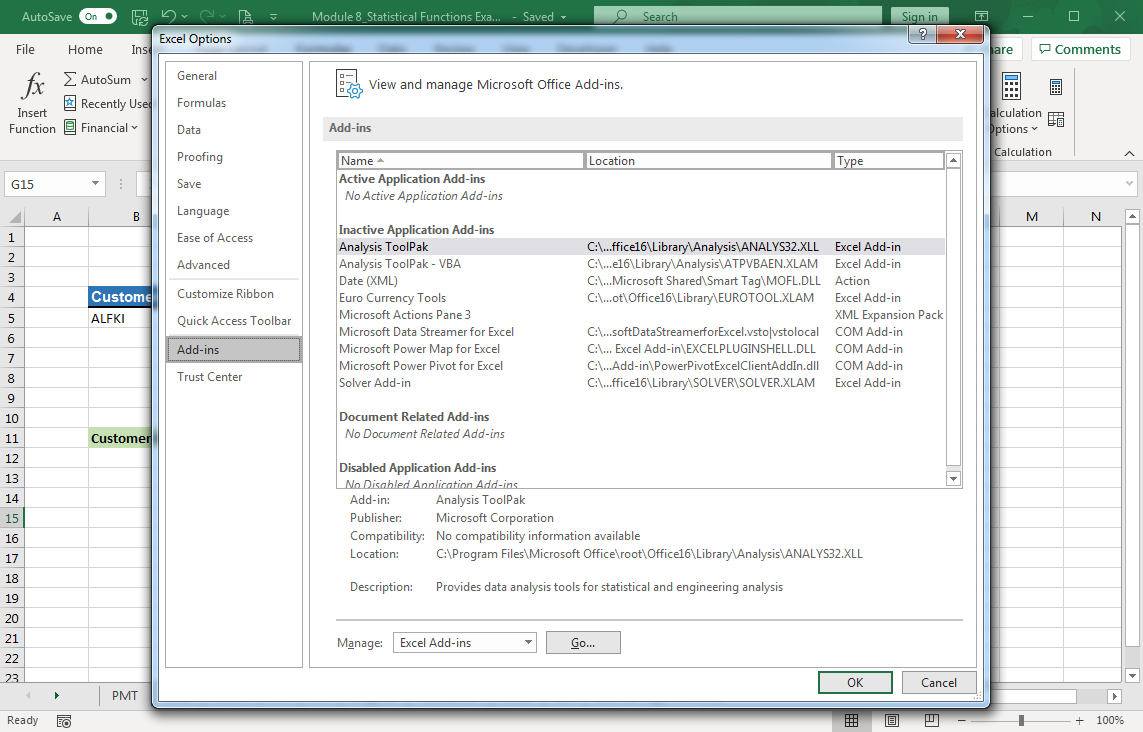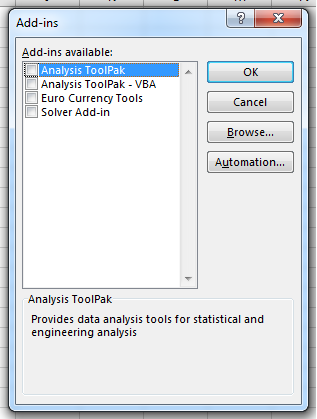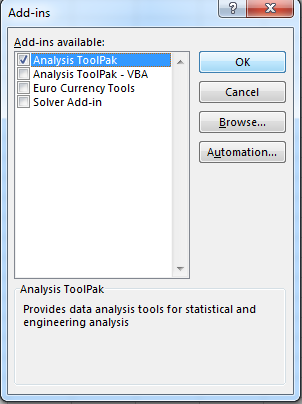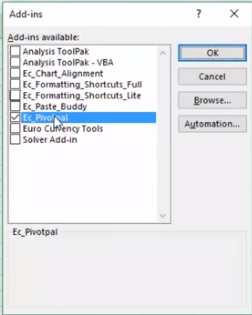8.18: Add-Ins
- Page ID
- 46555
Learning Objectives
- Use add-ins
Microsoft Office allows for a variety of additional programs to be added into Excel as well as the other Office programs. An add-in specifically adds optional features or commands into Excel either from Microsoft or from third-party companies. Excel’s default is to not make add-ins immediately available, therefore, in order to access them, you must install and sometimes activate the add-ins.
Here are general pieces of information to know before we dive into Excel add-ins:
- Add-ins are available for both Windows and for MacOS.
- The Options window is the main way to access and manage Excel add-ins. Find them by going to File, Options, Add-ins path. The Excel Options, Add-ins options selected is displayed in the screenshot below. Notice how you can see which add-ins are Active, Inactive and Disabled as well as any Documents related to add-ins.

- There are three main categories for the different types of add-ins: Excel add-ins, Custom add-ins, and Downloadable add-ins. We’ll go over an example for each of the three types to give you a good idea how to find, add-in, activate and run an add-in in Excel.
Excel Add-ins
These add-ins include ones with the extensions .xlam (marco-enabled add-in), .xla (Excel 97-2003 add-ins), .xll (DLL add-in or an automation add-in. Examples include the Analysis ToolPak, Analysis ToolPak – VBA, or the Euro Currency Tools add-in. Microsoft add-ins are listed in the Options window.
Here is how to enable an included add-in from Microsoft. Let’s say you wish to have the Analysis ToolPak available in Excel. Follow these steps:
- After opening the Options window, Add-ins on the left-hand menu selected, search and click on Analysis ToolPak in the list to see that it is disabled.
- At the bottom of the Options window, in the Manage drop-down menu, select Excel Add-ins, click Go.
- The Options window closes, and a new small dialog box opens. See the ToolPak box isn’t checked. Check that box and click the OK button.


- Excel takes a few seconds loading up the add-in and then it will show up in your ribbon area usually. In this case, in the Data tab, on the far right a new group appears called Analysis, Data Analysis button.

This ToolPack adds-in many additional data analysis tools you can use. Scroll through the menu to see the options. Many are additional statistical analysis options.

- Now if you return to the Options window you will see that the Analysis ToolPack is activated. If you wish to deactivate this add-in, return to the Options, Add-ins, Manage, Excel Add-ins, and click Go to open the Add-ins dialog box again. Simply uncheck the box and click OK to disable the Analysis ToolPack.

- This same process is used for the included Microsoft Add-ins in Excel. COM Add-ins are also Microsoft’s add-ins that are available in Excel as well and can be added or disabled by opening its dialog box and clicking on the available add-ins as well.
Downloadable Add-Ins
If you are surfing the internet looking for a good add-in for Excel, you will find many add-ins provided by a large variety of program providers, software developers and businesses. Let’s walk through a scenario to see how to install a downloaded add-in into Excel.
Let’s say you found the website www.excelcampus.com or some other website, and decided you would like to use the Excel Pivotpal add-in to make your pivot tables a bit more customized. Follow these steps to get the add-in into your Excel program.
- After purchasing the add-in, download it into your download folder on your computer. (Double clicking does not add it automatically to Excel, you need to go through the Add-in in the Options menu.)
- Open Excel, File, Options, Add-ins menu and the window displays the available add-ins.
- At the bottom of the window, in the Manage, choose the Excel Add-in, and click Go.
- The Add-ins window will open but you will not see the file you downloaded. You need to now go find that file. Click on the Browse… button and it will open a new window. It usually defaults to the Microsoft > AddIns folders. Navigate to where you saved the downloaded add-in file and select it, click OK.
- It will now be added into the Add-ins menu in the small window. Now check the box and click OK to enable the downloaded add-in.

- Once an add-in is enabled, there is no need to re-install, it loads and opens each time you open Excel.
- To disable it follow the same path to open the Add-ins window and deselect the custom add-in.
Custom add-ins
A custom add-in is one you create yourself–this is useful when you must run a macro often for different workbooks—or created by solution providers or programmers based on the COM (Component Object Model). These custom add-ins often require Visual Basic or other programming languages to build. As you become more proficient in Excel or Visual Basic, you may wish to create your own custom Excel add-in.
The flexibility of Excel allows for all kinds of custom add-ins. Many custom add-in files may be added into Excel just like with a downloaded add-in file process.
Additional access to Microsoft Add-ins
Excel, and the other Office 365 and 2019 programs, have an additional way to find other add-ins available from Microsoft. In the Insert tab, find the Add-ins button. Once you click on that button choose one of the options. Here is what this looks like:

After selecting the Get Add-ins option, a new window opens, and you can scroll through and select a variety of add-ins to use for Excel and the other Office products.

PRactice Questions
Add-ins can be powerful tools to assist with Excel’s already useful functions. Now that you know how to search, find, download and add in these tools, find the ones that fit your needs the best and enable them to make your work life more efficient.
Contributors and Attributions
- Add-Ins. Authored by: Sherri Pendleton. Provided by: Lumen Learning. License: CC BY: Attribution

